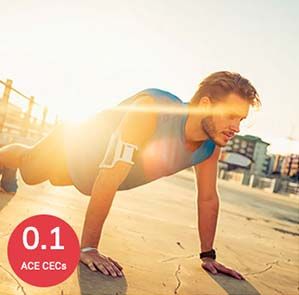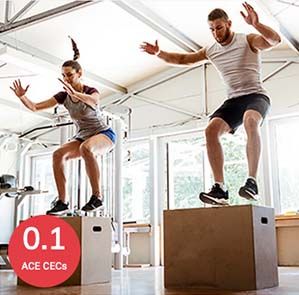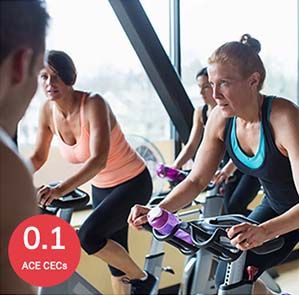
Save Time With This HIIT Resistance-training Workout

Many people are constantly on the lookout for ways to accomplish more in less time—and exercise is no exception. In fact, overloaded calendars and increasingly busy schedules are likely among the top reasons why high-intensity interval training (HIIT) has become so popular over the past decade or so. After all, the appeal of HIIT is obvious: It promises equal or better results in less time than traditional training programs.
Much of the research on HIIT, which involves alternating between brief bouts of high-intensity exercise with either rest or lower-intensity work during an exercise session, has focused on cardiorespiratory exercise. These studies confirm that performing HIIT regularly improves cardiorespiratory fitness and vascular function in a time-efficient way.
There has, however, been a noticeable lack of research examining resistance training through this same lens. To address this gap, ACE-supported research compared the effectiveness of traditional moderate-intensity resistance exercise (MI-RE) to a form of resistance training that follows a HIIT format (HIIT-RE). Specifically, the researchers compared the muscular fitness and cardiometabolic outcomes, as well as the timing of training adaptations, between the two models.
The researchers recruited 48 nonsmoking men and women ranging in age from 21 to 59 years old. All participants were low-to-moderate risk and reported no resistance training within the previous six months. They were instructed to maintain their dietary habits for the duration of the study and to avoid any exercise beyond that required for the research.
Participants were randomly placed into three groups—a non-exercise control group, a HIIT-RE group and an MI-RE group. The following measurements were taken for all participants before and after a six-week resistance-training program (completed by the two training groups): resting heart rate and blood pressure; height, weight, waist circumference and skinfold measurements; and fasting blood lipids and blood glucose. The researchers also identified participants' one- and five repetition maximums (1-RM and 5-RM) for the following 10 exercises:
- Back extension
- Biceps curl
- Chest press
- Lat pull-down
- Leg curl
- Leg extension
- Leg press
- Seated row
- Shoulder press
- Triceps extension
The HIIT-RE group performed one set of five repetitions of each of the 10 exercises for the duration of the program, while the MI-RE group performed one set of 10 repetitions for the first half of the program and then two sets of 12 repetitions for the second half. The HIIT-RE workouts took 20 minutes or less to complete, while the MI-RE workouts took about 45 minutes to complete.
The results showed that body-fat percentage decreased significantly for both resistance-exercise groups, while systolic blood pressure and low-density lipoprotein (“bad”) cholesterol decreased significantly in the HIIT-RE group only.
In terms of muscular fitness, there were significant improvements to all 1-RM and 5-RM values for members of both training groups. That said, HIIT-RE elicited greater improvements than MI-RE for seated row and leg press (both 1-RM and 5-RM), as well as for the chest press and lat pull-down (5-RM only). And, when it comes to the timeframe over which these improvements are achieved, increases in muscular fitness occurred more rapidly with HIIT-RE than with MI-RE.
The bottom line is that HIIT-RE is equally effective as (and in some instances more effective than) traditional MI-RE at improving cardiometabolic health and muscular fitness. It’s also important to reiterate that the 20-minute HIIT-RE workouts were considerably more time-efficient than the 45-minute MI-RE workouts.
The same or better results in less time is a recipe for success.
Here is a fun and challenging HIIT resistance-training workout modeled after the one used in the ACE-sponsored research that you can use with your clients. ACE Certified Pros also have access to a printable PDF (at the link at the top of this page), which you can share with your clients to use between sessions. If you or your clients don’t have access to the equipment featured in any of the exercises, use the ACE Exercise Library to find one that better meets your needs.
- Perform this routine two or three days per week.
- Perform each exercise for one set of five repetitions. Note that it is important to use a weight that can be lifted for a maximum of five repetitions. For example, if a client can lift the weight they are using for only four repetitions, it is too heavy; if they can lift it for more than five repetitions, it is too light.
- Perform each exercise in the order listed.
- Take little to no rest (approximately 20 seconds) between sets. This should simply be the time it takes to transition from one exercise to the next.
- Total workout time should be around 20 minutes.
HIIT Resistance-training Workout
Exercises
Expand Your Knowledge
 |
Busy Days Call for HIITWith lots to do on any given day, HIIT training can be a great way to maximize both time and caloric burn. A misconception about HIIT training is that only experienced athletes should perform this type of workout. This ACE LiveClass debunks that myth and presents scientific data on why HIIT intervals should be incorporated into everyone’s workout routine. |
 |
Programming the Ultimate HIIT WorkoutDelve into the science behind HIIT so you can confidently program high-intensity workouts for clients of all types. In this video training, you’ll also uncover the versatility of this in-demand training and explore how HIIT can be applied outside (running, cycling, rowing, cross country skiing), inside (treadmill, elliptical, stair climber, stationary bike) and in a group environment using body weight or equipment. |
 |
Integrating HIIT into Indoor CyclingIn this video training, you’ll build a solid foundation of research-based HIIT protocols and strategies to successfully implement into your indoor cycling classes and keep participants engaged. You’ll also examine communication and motivational strategies as well as the highlights of recovery coaching strategies for HIIT classes. |

More Articles
- Certified™: February 2023
How to Find the Right Balance Between Coaching and Training
Contributor
- Certified™: February 2023
Outdoor Winter Exercise: 7 Key Programming Considerations
Contributor




 by
by 

